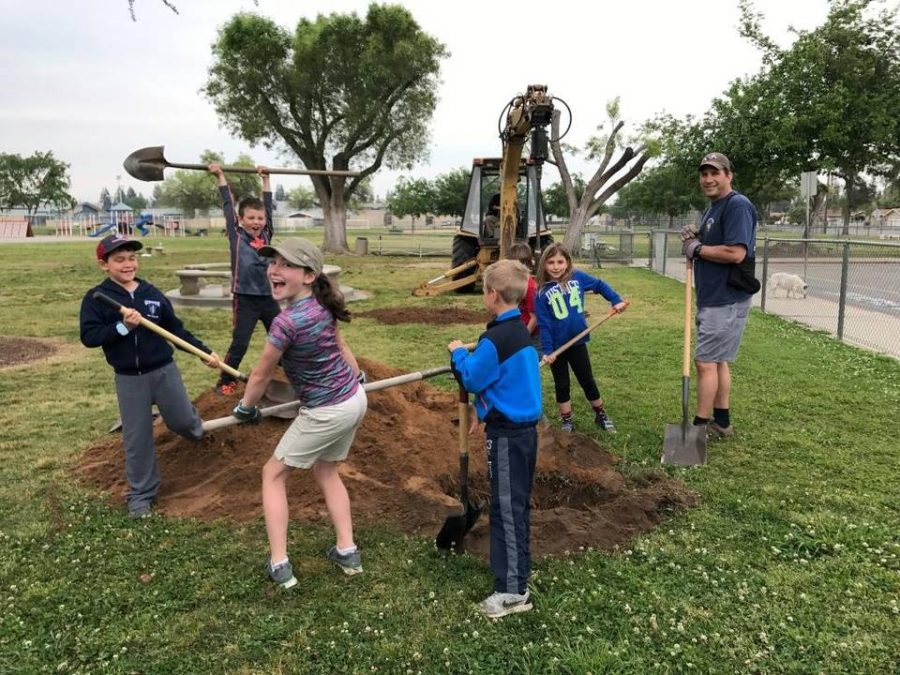
I am the father of a second and fifth grader in the Fresno Unified School District. I coach their soccer teams and actively participate in school activities. We compete on fields with little to no shade, and often my kids are indoors on smog-infused days. I seek to change this.
A majority of Fresno’s landscape emphasizes urbanization and irrigated turf. We can create a better framework for our city by highlighting our own endemic valley oak, a tree emblematic of our region.
Earth Day, 2015, in partnership with Tree Fresno, students successfully planted 25 valley oaks at Wawona Middle School. Last Saturday, Earth Day 2017, students again partnered with Tree Fresno. They gathered plans, funds and irrigation, planting eight large-canopy, drought-tolerant trees at Ruth Gibson Elementary School.
What’s the point? There are multiple reasons for these endeavors:
▪ School tree transition: Assist Valley schools to transition from short-lived mulberry and Modesto ash trees , to more appropriate long lived, drought-tolerant trees.
▪ School mobilization: Engage the school communities in all aspects planning, fund-raising, planting, and supervision. In the short term, it generates positive publicity for schools. For the long term, it provides an environmental education setting for generations.
▪ Education: Students engage in hands-on experiential learning through all stages of development from fund-raising to installation. Student participation will increase pride and ownership of the school community. Planted specimens will provide a living science lab for students of all grade levels for generations. Once educated on the natural, cultural, biological and ecological value, some students will become lifelong stewards of our Valley’s trees.
▪ Shade: Temperature in the canopy shade is 10 degrees cooler than in direct sun. Properly located on fields, the shade provides relief for students, parents, coaches, and athletes before, during and after play.
▪ Carbon sink: Valley oaks grow 70 feet wide by 70 feet tall. Throughout their more than 400 years of life, they take in massive amounts of carbon and convert it to oxygen and biomass through photosynthesis.
▪ Endemic: Valley Oaks are distributed throughout the Valley’s grassland ecosystem. They have evolved over the eons specifically to our arid climate and sandy loam soil.
▪ Drought tolerant: Water requirements change over time. During establishment, drought-tolerant trees need deep-root irrigation. After establishment, their tap roots use ground water, and surface watering may not be necessary. They use significantly less water over their lifetime than irrigated lawn.
▪ Natural barrier: Mature trees provide a natural barrier for wind, dust, noise, and pollution. Neighborhoods surrounding schools will benefit once these trees are established.
▪ Biological diversity: Valley oak habitats can support more than a hundred native species of birds, amphibians, mammals, and invertebrates. Similar-sized species support only a raction of this wildlife.
▪ Restoration: Over the past 200 years, 90 percent of valley oak habitat has been cleared for agriculture and urban development. Inadequate natural regeneration further impacts the species. The California Department of Fish and Game and the Nature Conservancy considers these trees threatened. Planting in our community will begin to reintroduce these trees into our urban landscape.
▪ Cultural heritage: The acorns from valley oaks wereused as a staple for native people in the Valley. Europeans settled near valley oak groves to feed their pigs with the acorns and farm the fertile soil.
▪ Iconic: Valley oaks are the largest of North American oaks and showcase the climax ecosystem for Central California. Ideally located in urban landscapes, they make a profound statement in terms of beauty, ecology, and restoration. Just as sequoias are the icons of the sierras and the redwoods are the icons of the Northern California Coast, valley oaks are the natural icons of the Valley.
▪ Economic value: Mature trees have been shown to measurably increase the economic value of a region. Desirability and value of nearby properties increases over time with trees maturity.
Lets make our community beautiful. When planting a new tree, I urge you to consider the valley oak. For future projects in the Valley involving valley oaks, you can donate to Tree Fresno – Valley Oak Project.
